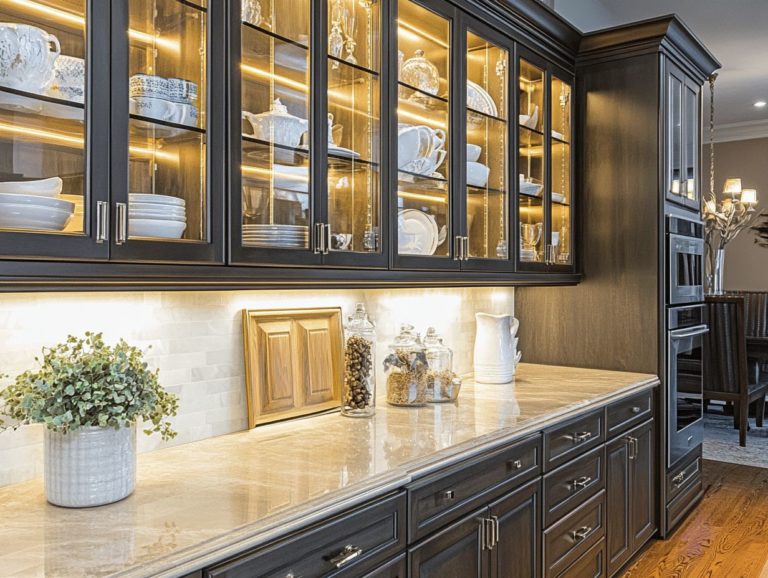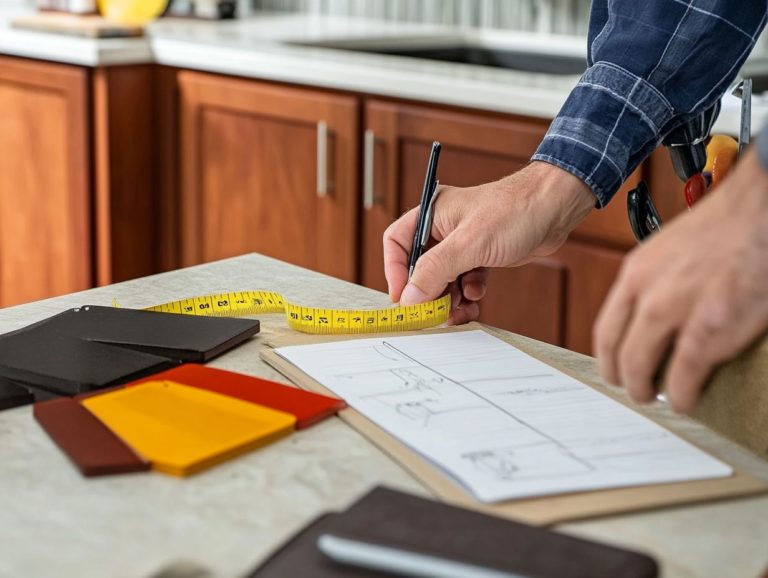Understanding Cabinet Construction Types
When you set out to design your dream kitchen or bathroom, the choice of cabinets is crucial. It influences both the look and functionality of the space.
With various cabinet construction types available, it’s vital to understand the distinctions between framed, frameless, semi-custom, and custom cabinets.
Each type has unique characteristics, advantages, and drawbacks that can significantly affect your renovation project.
Get ready to explore the best options for your dream space!
Contents
Key Takeaways:

Framed cabinets are traditional and have a frame on the front, providing support and stability. They offer a classic look but can limit access to the interior space.
Frameless cabinets, known as European style, have a sleek, modern appearance and offer maximum access to the interior space. However, they may lack the structural support of framed cabinets.
Semi-custom and custom cabinets offer more design options and can be tailored to specific needs. However, they tend to be more expensive and may have longer lead times compared to pre-made options.
What are Cabinet Construction Types?
Cabinet construction types play a crucial role in kitchen design. They affect both the look and functionality of your renovation.
With options like framed, frameless, semi-custom, and custom cabinets, each brings unique characteristics tailored to your needs.
By understanding these types, you empower yourself to make informed decisions based on your desired cabinet features and kitchen style. This knowledge ensures your remodeling project aligns with your vision, transforming your space into the culinary haven you’ve always dreamed of.
Framed Cabinets
Framed cabinets are known for their robust construction. They showcase a face frame that not only offers structural support but also enhances the overall look of the cabinetry.
This combination of durability and beauty makes them a favored choice for those who love traditional designs.
Definition and Characteristics

Framed cabinets feature a face frame that enhances structural integrity and allows for various door styles, such as full-overlay and partial-overlay doors.
This versatility makes them suitable for both modern and traditional settings.
Constructed from materials like solid woods, plywood, and engineered options, framed cabinets offer distinct advantages in durability and design.
You’ll find an impressive selection of finishes, colors, and hardware choices that can be tailored to suit your personal style.
Thanks to their structured frame, these cabinets provide enhanced support, prolonging their lifespan while maintaining a polished look that complements a broad spectrum of design preferences.
Pros and Cons
Framed cabinets are celebrated for their sturdy construction and timeless charm. However, there are drawbacks to consider.
On the upside, these cabinets often boast durability, making them perfect for high-traffic areas. Their design flexibility allows you to choose from a wider array of styles and finishes that enhance your interior décor.
However, keep in mind that framed designs may limit storage space since the frame can encroach upon the interior dimensions. Balancing your aesthetic desires with practical needs is key when considering these popular storage solutions.
Frameless Cabinets
Frameless cabinets are crafted without a face frame, providing you with full access to the cabinetry.
This design maximizes storage space while delivering a sleek, modern look that harmonizes beautifully with contemporary kitchen styles.
Ready to transform your kitchen? Let’s find your perfect cabinets!
Definition and Characteristics

Frameless cabinets offer a sleek, modern look, creating a seamless transition between cabinet interiors and your kitchen design. They provide ample storage, making them ideal for contemporary spaces.
This construction method removes the face frame found in traditional cabinets, resulting in wider openings and easier access to essentials. Their design maximizes usable space while enhancing aesthetic appeal.
With a variety of finishes available—ranging from high-gloss laminates to natural wood veneers—you can personalize your kitchen while maintaining that clean, modern feel.
These cabinets emphasize efficiency, merging functionality with elegance in tune with the latest kitchen décor trends.
Pros and Cons
The advantages of frameless cabinets are compelling. They offer enhanced storage capabilities and a sleek aesthetic.
For example, their innovative design maximizes interior space, allowing for deeper shelving and more accessible storage, which is particularly beneficial in smaller kitchens.
The seamless appearance adds contemporary flair, making frameless cabinets a favorite in modern renovations. However, there are construction challenges to consider.
Precise measurements are critical, and installation may pose difficulties. These drawbacks need careful consideration.
The absence of a frame may also compromise structural integrity, raising concerns about durability over time, especially in high-traffic areas.
Semi-Custom Cabinets
Semi-custom cabinets provide a great mix of personalization and cost-effectiveness. You can select features, styles, and finishes that align with your unique kitchen design while avoiding the hefty price tag of fully custom cabinetry.
Definition and Characteristics

Semi-custom cabinets offer an impressive range of options, allowing you to personalize your cabinetry while keeping it budget-friendly.
You can choose from materials like rich hardwoods and durable Medium Density Fiberboard (MDF), giving you flexibility to match your style. Finishes such as matte, gloss, or stains not only elevate aesthetics but also provide essential protection against wear.
Choosing the right drawer styles—whether standard, soft-close, or deep options—can enhance usability and design. This adaptability makes semi-custom cabinets an exceptional choice for any kitchen layout.
Pros and Cons
While semi-custom cabinets offer notable flexibility and affordability, they also have limitations. Consider these carefully during your renovation planning.
These cabinets strike a balance between fully custom options and stock cabinets, appealing to homeowners seeking personalization and cost-effectiveness.
One major advantage is the ability to adjust specific dimensions and styles, optimizing your space without splurging on bespoke solutions. However, keep in mind that your choices might be a bit limited compared to fully custom cabinetry.
As you weigh your options, consider how these factors align with your vision and budget. This ensures an informed decision that satisfies both aesthetic desires and practical needs.
Custom Cabinets
Custom cabinets are crafted to align perfectly with your unique needs, offering unmatched flexibility in size, design, and materials. This makes them a fantastic choice for anyone wanting to elevate their kitchen with a personal touch.
Definition and Characteristics
Custom cabinets are made to order to fit your specific dimensions, styles, and functionalities, offering a personalized touch that enhances both the utility and visual appeal of your kitchen space.
These unique creations blend effortlessly with your existing decor, showcasing various finishes and materials—from rich hardwoods to sleek modern composites.
By choosing custom features like intricate moldings, built-in storage, and personalized hardware, you can achieve a delightful balance of elegance and practicality that mass-produced alternatives simply can’t provide.
The craftsmanship behind these cabinets reflects a commitment to quality and artistry, ensuring each piece serves as both a functional necessity and a stunning focal point in your room.
Pros and Cons
Custom cabinets deliver an unparalleled level of personalization and quality. However, it’s essential to be mindful of the costs and extended lead times that come with them.
Investing in custom cabinets can elevate your space into a reflection of your unique style and functionality. The design flexibility inherent in custom cabinetry allows you to maximize storage while achieving an aesthetic that’s distinctly yours.
Luxurious materials can significantly increase costs. It’s important to weigh these elements against the standard options available on the market.
While the craftsmanship of custom cabinets results in stunning, one-of-a-kind pieces, you may also encounter longer wait times before your vision is fully realized.
Frequently Asked Questions
What are the different types of cabinet construction?
There are three main types of cabinet construction: framed, frameless, and inset. Each type has its own unique characteristics and design elements.
What is a framed cabinet?
A framed cabinet has a face frame attached to the front of the cabinet box. This construction provides additional stability and support, but can limit storage space inside the cabinet.
What is a frameless cabinet?
A frameless cabinet, also known as European style, has no face frame, with doors and drawers attached directly to the cabinet box. This allows for more storage space inside the cabinet but may not be as strong as a framed cabinet.
What is an inset cabinet?
An inset cabinet has doors and drawers set inside the frame, creating a flush appearance. This construction requires precise measurements and may be more expensive, but provides a high-end, custom look.
Which type of cabinet construction is best for my kitchen?
The best type of cabinet construction for your kitchen depends on your personal style and budget. Framed cabinets are a traditional choice, while frameless and inset cabinets offer a more modern look.
How do I know if I have high-quality cabinet construction?
High-quality cabinet construction should have strong joints, smooth finishes, and sturdy hardware. Consider the materials used and the reputation of the manufacturer or contractor. Consulting with a professional can also help determine the quality of your cabinets.





